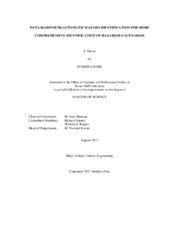| dc.description.abstract | As chemical process plants have become more involved and complex, the likelihood of hazardous incidents has increased simultaneously. That is, the more complex a facility’s systems, the more factors engineers must consider. This results in a higher likelihood of potential hazards being overlooked; thus, the possibility of incidents occurring increases.
Many companies and organizations are struggling to identify their weaknesses and reduce hazardous issues by developing hazard identification (HAZID) tools, particularly for large and complex processes. Even though a considerable number of companies merely pursue this objective to conform to government regulations, their efforts play a critical role in improving their reputations and financial profits. Therefore, the advancement of HAZID tools in the process industries has taken significant strides over the last 40 years.
Despite the substantial development of HAZID methods, traditional HAZID tools need further development because of their weaknesses in identifying possible hazards. In other words, it is evident that unintended incidents that occasionally occur in the chemical process industry require more enhanced HAZID methodologies. Therefore, this study attempts to ascertain the drawbacks of existing HAZID tools so that a new HAZID methodology, data-based semi-automatic hazard identification (DAHAZID), is proposed.
Considering potential HAZID methodologies, this study seeks to identify possible scenarios with a semi-automatic and systemic approach. Based on the two traditional HAZID tools, Hazard Operability study (HAZOP) and Failure Mode, Effects, and Criticality Analysis (FMECA), the DAHAZID method will minimize the limitations of each individual method. Additionally, rather than depending on the HAZID tools to achieve the connectivity of the process system, this study will consider connections with other new technologies in advance. Then, this method can be integrated with proper guidelines regarding process design and safety analysis. To examine its usefulness, the method will be applied to two case studies, and its outcome will be compared to the actual result, performed previously by a traditional HAZOP meeting.
Hopefully, this research can contribute to the further development of the process safety field in practice. | en |


